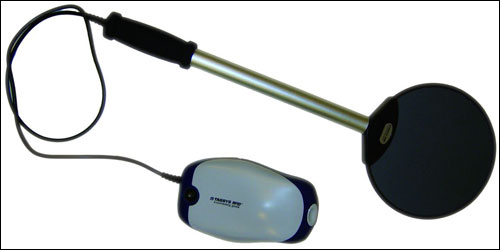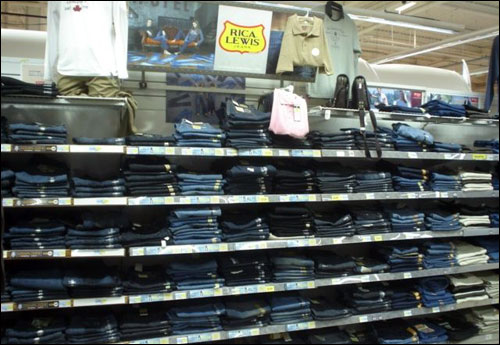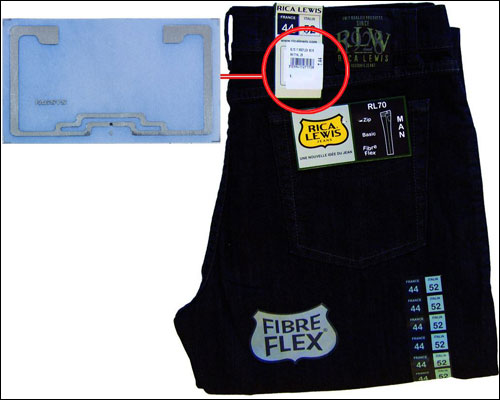Rica Lewis, a French clothing manufacturer specializing in jeans, is employing radio frequency identification to boost sales and improve customer relations by outfitting its traveling salespeople with RFID readers so they can conduct quick inventories during store visits.
Instead of spending one hour counting merchandise in an in-store boutique to determine which sizes and styles are in stock and which require replenishment, a Rica Lewis salesperson can use a handheld reader to interrogate the RFID tags on all of the boutique’s garments in only 10 minutes. This frees up that salesperson, and enables more interaction with the customer (the retailer) and a greater focus on sales. The data that the salesperson collects on the interrogator is moved to a laptop computer, and then transmitted to the company’s server via GPRS, so that replenishment orders can be processed immediately.
RFID solutions provider Tagsys supplied the system, and Didier Mattalia, the company’s sales director for fashion and retail, believes the project might be a first for a clothing manufacturer that distributes its brand to multiple points of sale at large retail stores, as opposed to a clothing maker that runs its own stores. “This is a really different way of using RFID at the retail level,” he says. In 2007, Tomorrow’s Mother, a North American manufacturer of maternity apparel, adopted a somewhat similar RFID system (provided by Seeonic, and incorporating SkyeTek RFID interrogator modules), whereby it supplied tagged garments and RFID-enabled fixtures to U.S. and Canadian department stores that sold its products (see Maternity Apparel Maker to Deploy Smart Displays in Stores).
Rica Lewis began implementing its system in November 2009, at retail locations in Paris and the south of France. Two salespeople for these regions cover a combined total of 40 to 45 stores. By the end of 2010, the company expects to complete a rollout across France, as well as in Belgium. At that point, some 40 traveling salespeople will carry RFID handheld readers to conduct on-the-spot inventories.

The system is based on Tagsys’ fashion and specialty retail solution. Rica Lewis employs a Toshiba TEC RFID printer to encode a unique ID number to a Tagsys EPC Gen 2 RFID tag adhering to the paper label that will be attached to each garment. The clothing company ships the encoded labels to its suppliers, which can then apply them to the appropriate garments and ship the tagged goods to Rica Lewis’ distribution center (DC) in Fossana, Italy. Currently, the garment suppliers tag roughly 100,000 items per year, destined for stores in the two regions set up for RFID. By the end of this year, Rica Lewis expects to be tagging its full stock of more than 5 million items that it sends to all regions annually.
At present, Rica Lewis is not interrogating the tags as goods arrive at its DC, though it does plan to add this step to its RFID-based logistics processes as soon as possible. Instead, the first reading of a garment’s RFID tag is taken after picking is completed. Already at the garments’ point of production, Rica Lewis knows to which stores goods are headed. This enables it to ensure that all clothing intended for the two RFID-enabled regions are tagged. Once a Fossana employee has picked the goods for shipping, he or she uses one of two tabletop readers to identify the items in boxes, and to confirm that the proper garments have been picked. Rica Lewis’ salespeople perform the second and final tag reading upon conducting in-store inventory. The company intends to add readers to identify goods loaded onto trucks as well.

“Rica Lewis started by enabling RFID-based inventory, because that was what it sought most out of the application,” Mattalia says. However, he notes, “It’s always better to implement RFID throughout the supply chain, if possible.”
Rica Lewis indicates it benefits from the system’s ability to speed up the replenishment process, improve customer relations (since sales managers now spend more time building relationships than taking inventory) and promote a positive image among its retailer customers—which include Carrefour, Groupe Casino and Auchan Group—by enabling Rica Lewis to present itself as a technology leader.
“The speed and accuracy of this technology have allowed us to cut by 80 percent the time sales managers spend performing onsite inventories at our retail customers,” says Dominique Lanson, Rica Lewis’ CEO. “They can, therefore, spend more quality time with the customers and enhance their sales approach.”
No testing on the system was necessary, Mattalia says, since Tagsys’ fashion and specialty retail solutions have been repeatedly tested with other clients, which include Serge Blanco (see Serge Blanco Finds ROI in RFID). The system only needed to be customized to Rica Lewis’ ERP system, he says.
“Unlike some of the other technologies we deployed in the past,” Lanson adds, “it was not difficult to get our employees to accept this evolution. They quickly saw the benefits RFID brings to them, in terms of order preparation and inventories.”



